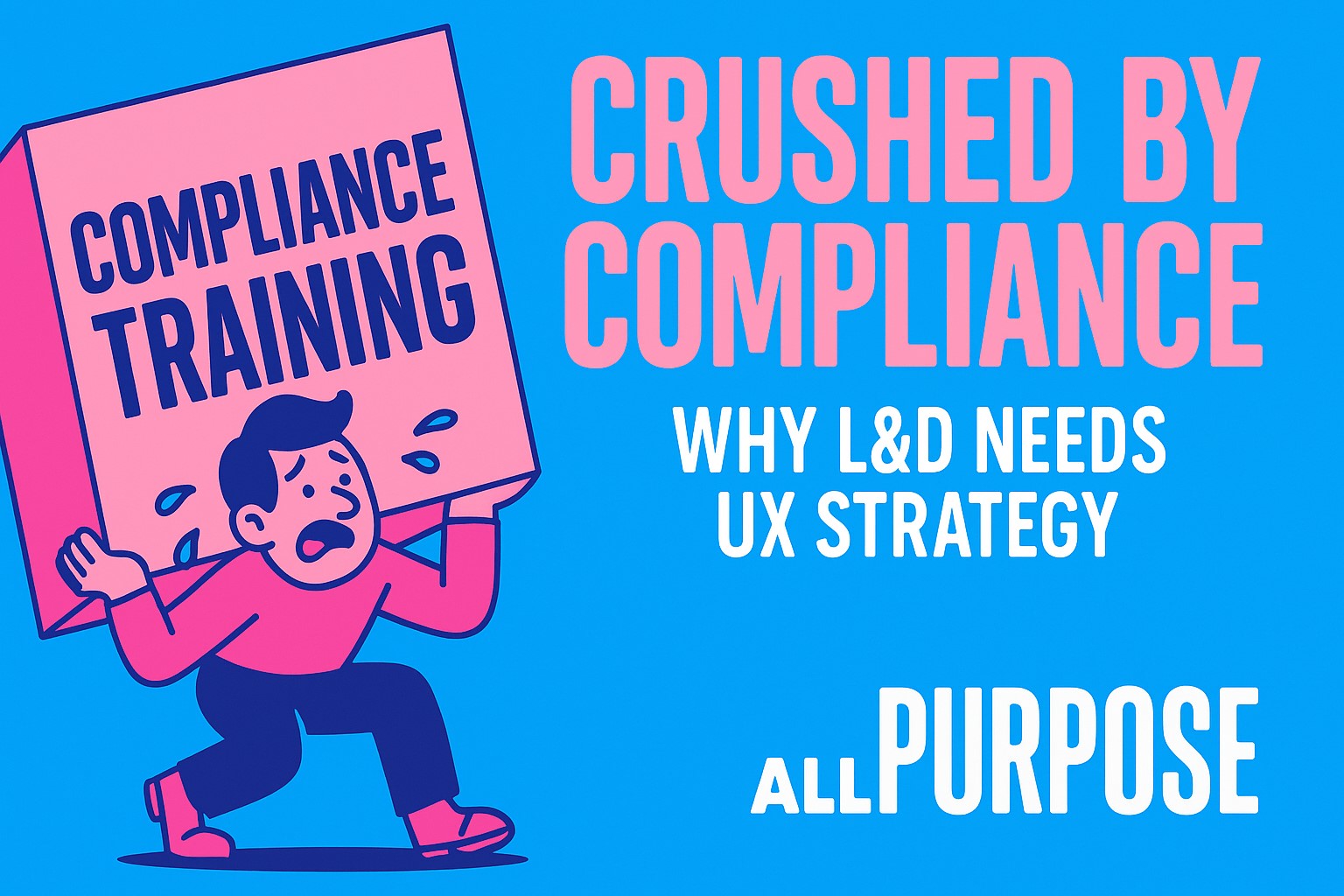
Crushed by Compliance: Why L&D Needs UX Strategy - Summit Solutions
Corporate learning is often criticised for being slow, outdated, or uninspiring - especially when it comes to compliance. But what if the problem isn’t the content, but the experience? In this month’s Summit Solutions, All Purpose argues that L&D must borrow from UX design: starting with empathy, centring the learner, and co-creating experiences that reduce friction, spark curiosity, and truly engage.
Let’s be honest: corporate learning - especially compliance-based training - doesn’t always have the best reputation. It often falls short; whether it's slow to load, visually outdated, or, worst of all, mind-numbingly boring. This isn’t due to a lack of effort. It’s often the result of something simpler and more fundamental: a disconnect from the learner’s experience.
Let us explain.
Learning teams work hard to meet compliance goals, roll out timely programs, and equip people with the tools they need. But when initiatives are designed around content first and users second, something gets lost. Logins stall. Drop-off rates climb. Engagement flatlines. And learners - real people with limited time and even less cognitive bandwidth - quietly disengage.
The intent is there. The impact isn’t.
If we want to build learning experiences that support actual growth, we need to borrow a principle UX (user experience), designers have lived by for decades: start with the end user.
From Content-Led to Learner-Led
Much of traditional corporate training is shaped by organizational priorities: “We need to launch this.” “We need people to know that.” “We need this to meet compliance.”
But user-centered design flips that script. It doesn’t begin with content, it begins with people.
In UX, the first step is empathy: understanding how users think, what they value, and where they encounter friction. From there, designers create with intention—crafting flows, interfaces, and experiences that feel intuitive and responsive to the person on the other side.
In L&D, that same principle applies. When we design with the learner’s perspective in mind - not just the subject matter expert’s - we create learning that’s not only clearer, but more meaningful and memorable. Because relevance matters. And relevance can’t be assumed - it has to be designed for.
Design Is a Learning Tool
When learning is user-centered, design is strategic and can best be described as “by them, for them.”
Good design reduces cognitive load. It organizes information in a way that mirrors how the brain makes sense of things. It anticipates confusion, removes unnecessary clicks, and builds momentum through interaction, not just instruction.
It also creates space for emotion. Because learning isn’t purely rational—it’s relational. People remember stories, not checklists. They absorb more when they feel seen, not scrutinized. And they’re more likely to grow when the design invites curiosity, not compliance.
UX best practices—like user journey mapping or persona development—are already widely used in other parts of the business. Why? Because they work. Higher engagement, stronger retention, and better adoption metrics all point to the same thing: design matters.
Imagine what would change if ALL learning was designed with those same tools as core elements of their learning design process.
Co-Creation Builds Better Outcomes
A truly learner-centered approach doesn’t just consider user needs after the fact—it invites learners into the design process from the beginning.
This is where L&D can lean on design thinking frameworks like IDEO's Design Thinking: Empathize. Define. Ideate. Prototype. Test. Each phase centers the user, not as a checkbox, but as a collaborator.
When learning experiences are co-created—with input from frontline teams, new hires, managers, and underrepresented voices—they become more inclusive, more accurate, and more impactful. That buy-in also builds trust. Learners are far more likely to engage with something they helped shape than something handed to them in a top-down cascade.
Compliance Doesn’t Have to Be Mind-numbing
Compliance training is often the clearest sign of a broken learning experience. Bloated, badly designed, and mandatory, it sends the wrong message: this isn’t for you—it’s for us.
Now imagine compliance built for the learner. Let them pre-test, skip what they know, and zero in on what they don’t. Time spent drops. Velocity rises. And suddenly, it’s not just a box to tick. It’s a moment that matters.
Intentional doesn’t mean overproduced. Sometimes all it takes is a smarter flow and a bit of choice to shift the whole experience.
From Content Delivery to Experience Design
Learning shouldn’t be something people survive—it should be something they remember.
That starts with a mindset shift. From learning as content delivery to learning as experience design. From telling to inviting. From assuming to asking.
User-centered learning isn’t just about better UX. It’s about respect. It’s about recognizing that the learner is not an obstacle to overcome—they’re the reason we’re doing this in the first place.
When we center their voice, their needs, and their experience, learning becomes more than a performance tool. It becomes a pathway to connection, culture and long-term growth
This article was written by the team at All Purpose, a B Corp creative agency based in Vancouver, Canada. We collaborate with mission-aligned organizations to design learning experiences that resonate, empower, and drive impact. Curious about how to apply user-centered design to your next learning experience? Let’s talk: hello@allpurpose.io | https://allpurpose.io


